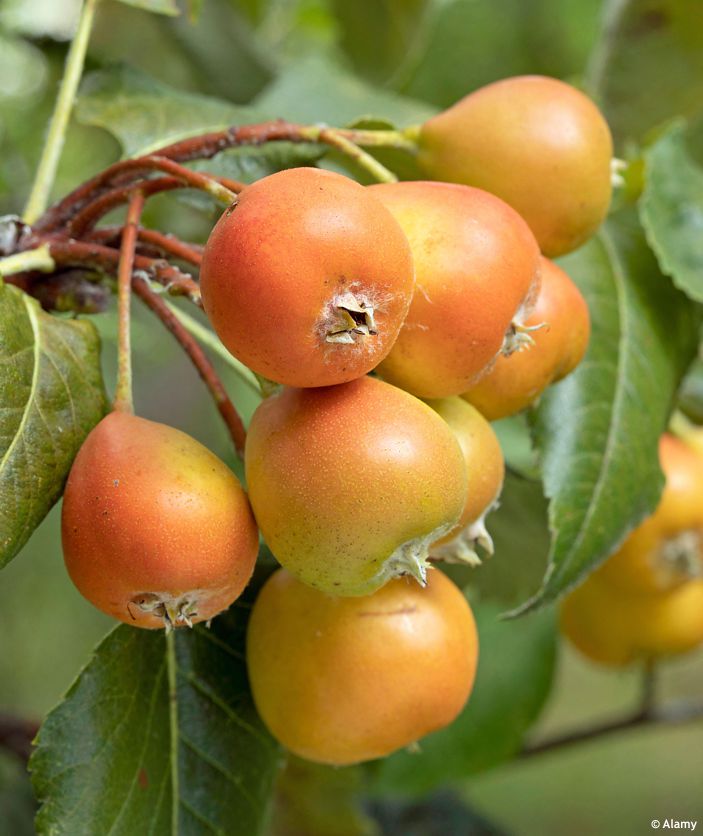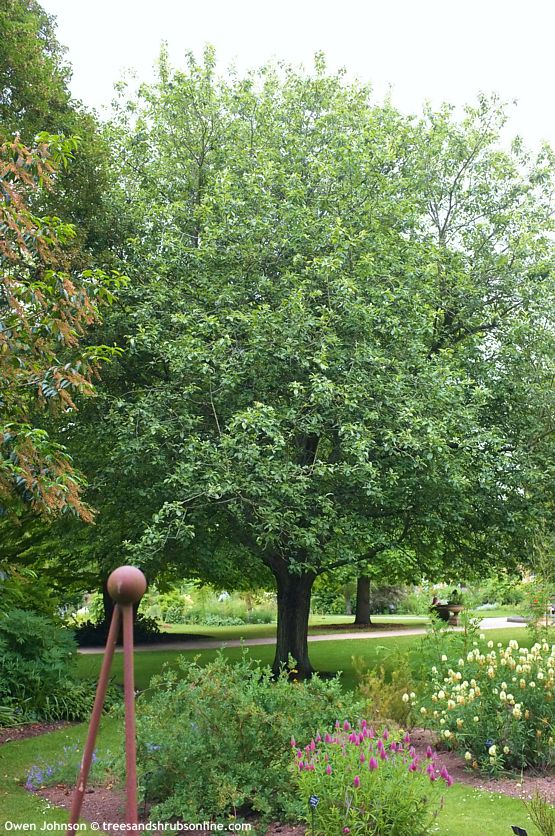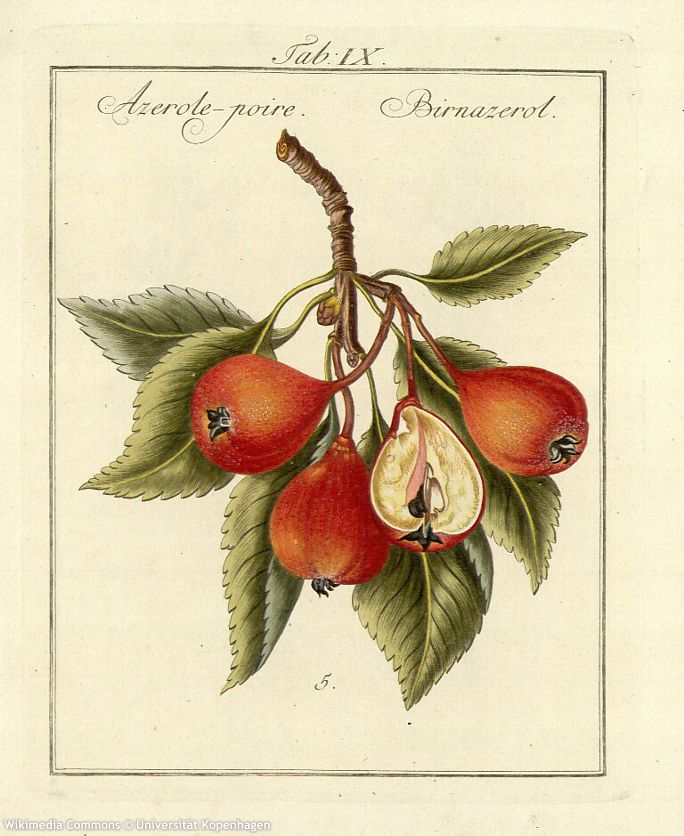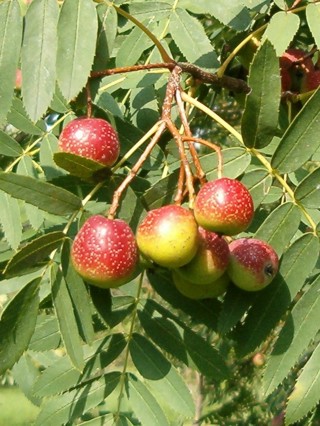×Sorbopyrus auricularis Bollwyller Pear
Sorbopyrus
The genera of pears (Pyrus) and rowans (Sorbus) both belong to the rose family and have been part of the European landscape for centuries. The common pear is a symbol of sweet fruit and fragrant orchards, while the rowan, with its silvery felted leaves and red pomes, is a familiar tree of meadows and slopes, often valued more as bird food and autumn ornament than as fruit for people. Both genera hold a place not only in agriculture but also in culture – the pear has long been associated with abundance and fertility, while the rowan was seen as a guardian tree, a symbol of resilience. Their union gave rise to the intergeneric hybrid ×Sorbopyrus – the Bollwyller Pear, a tree that combines the sweetness of the pear with the toughness of the rowan.
The first records of this unusual tree come from Alsace, where it was noted as early as 1599 and described by the Swiss botanist Jean Bauhin (1541–1613) in his monumental Historia plantarum universalis. In the small town of Bollwiller, in northeastern France, it became known as the “Bollwyller Pear” and was soon regarded as a horticultural rarity. Unlike the deliberate intergeneric experiments carried out centuries later by breeders such as I. V. Michurin, this tree is a spontaneous hybrid between the common pear (Pyrus communis) and the whitebeam (Sorbus aria). It appeared naturally, was recognized for its unusual qualities, and has since been preserved and propagated mainly by grafting, as it produces very few viable seeds. In the 19th century, several varietal forms were selected, such as ‘Bulbiformis’, ‘Malifolia’, and even a Central European selection called ‘Tatarova’, differing in leaf shape and fruit size.
The Bollwyller Pear is a medium‑sized tree, reaching 12–15 meters in maturity. Its crown is rounded, the branches thornless, and the bark grey‑brown and finely wrinkled. The leaves are ovate to obovate, dark green and glossy above, silvery‑felted beneath, giving the tree a soft, velvety look. In May it blooms with profuse clusters of white flowers, self‑fertile and attractive to bees and butterflies. The fruits ripen in September – small pear‑shaped pomes, usually 2–3 cm long, yellow with a red blush on the sunny side. The flesh is sweet, juicy, with a delicate buttery texture, tasting like miniature pears with a subtle rowan undertone. They do not store well – soon turning mealy – so they are best processed immediately after harvest. They make excellent jams, preserves, juice, or fruit wine, and thanks to their high pectin content they gel almost on their own.
As a garden tree it works beautifully as a solitary specimen, admired for its unusual appearance and autumn foliage, which turns shades of yellow‑orange to red‑orange, sometimes with a purplish tint. Enthusiasts of food forests and collectors of unusual fruit trees value it as a striking addition to orchards and forest gardens. It combines well with species of similar requirements – medlar, cornelian cherry, chokeberry, or sea buckthorn. In a forest garden it can form the upper layer, under which shrubs and herbs thrive. Its fruits are also a welcome food source for birds, adding to the biodiversity of the planting.
Cultivation is not demanding. It thrives best in full sun but tolerates partial shade. The soil may be loamy or sandy‑loam, with pH from slightly acidic to alkaline, but it must be well‑drained and moist. In the first years after planting, the main shoot should be staked to form a straight trunk. Standard tree forms require firm staking for the first three years, and the soil above the roots should be kept free of grass and weeds. Pruning is not essential, though light thinning in late winter encourages fruiting. It usually begins to bear after 8–10 years, which requires patience, but the reward is fruit with a flavour found nowhere else. Its hardiness reaches at least –30 °C, and some northern growers report even lower, making it perfectly suited to the harsher winters of temperate Europe.
Last update 22-10-2025.

1 100,75 Kč

1 317,5 Kč
Goods are shipped all over Europe. For Russia and U.K. and for further details please read about SHIPPING OPTIONS HERE.
Are you interested in a serious discount for orders NOV-FEB? Check your options here.
THE PRICES INCLUDE VAT of 15%. For quick conversion you can use 1 CZK = approx. 0.04 EUR
- STANDARD QUALITY - Plants of this group are 1st class quality with number of branches and overall density adequate to their size and age, considering they were container grown.
- DE LUXE QUALITY - This label guarantees a luxurious quality of manually selected plants that, compared to their height and age, are exceptionally dense and beautiful.
- EXTRA - These plants are usually mature and bigger specimens with exceptional overall appearance.
- STANDARD (as described in the plant form) means a tree with a trunk of 190-210 cm and a crown at the top, unless specified differently. The commercial size for trees is their girth measured in the height of 1m from ground.
- HOBBY - These plants are of the same quality as our standard-quality plants but younger and therefore cheaper.
- SHRUB - a woody plant with branches growing bushy from the ground level.
- HALF-STANDARD or MINI-STANDARD - a small tree with shorter trunk, its size is usually specified.
- FEATHERED - These are trees with branches growing already from the base of the trunk and up along the stem.
- GRASSES and PERENNIALS - Sizes given usually read the diameter of the pot or the clump, as specified.






























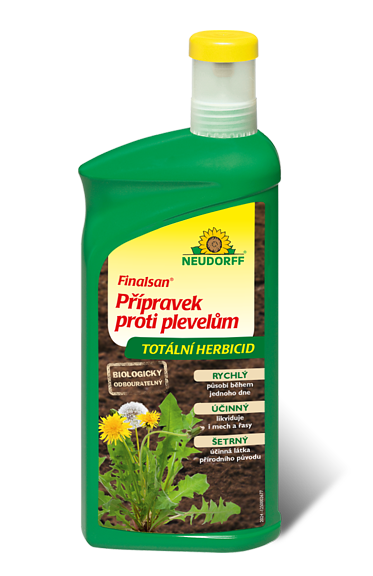


.jpg)
